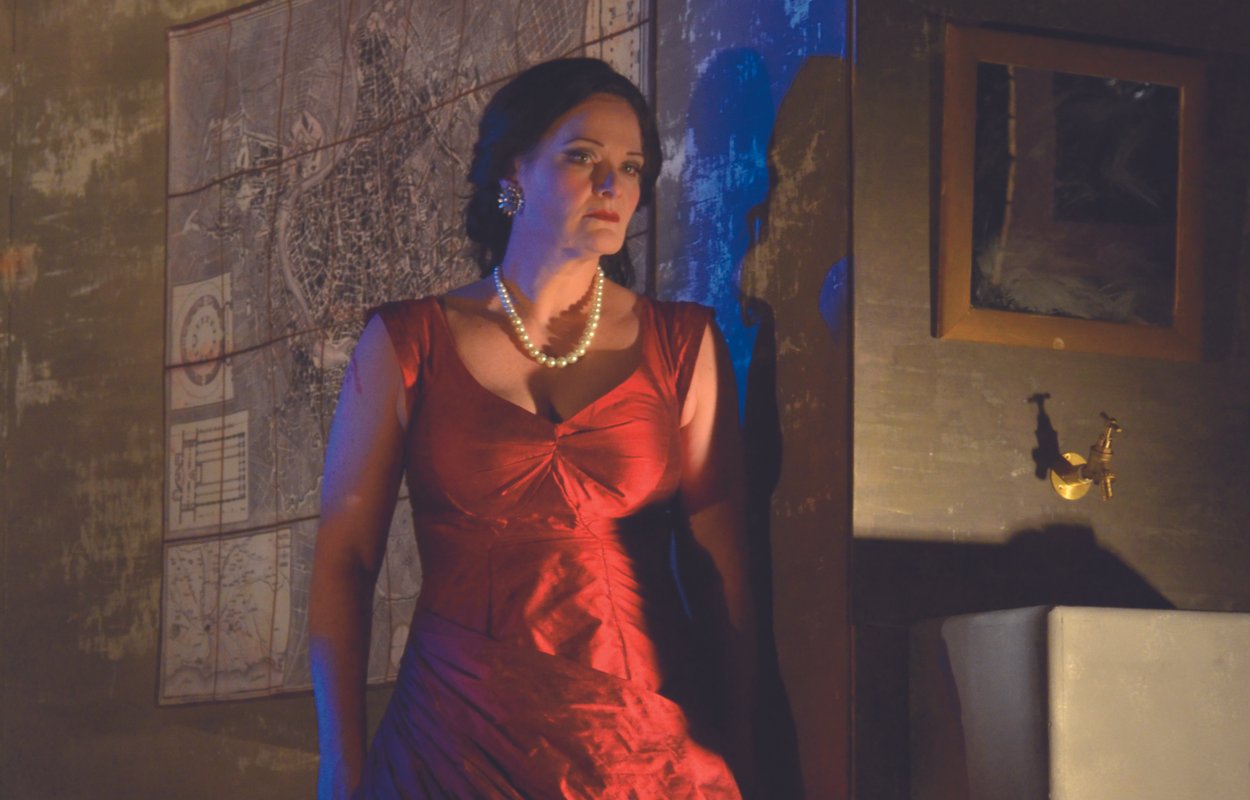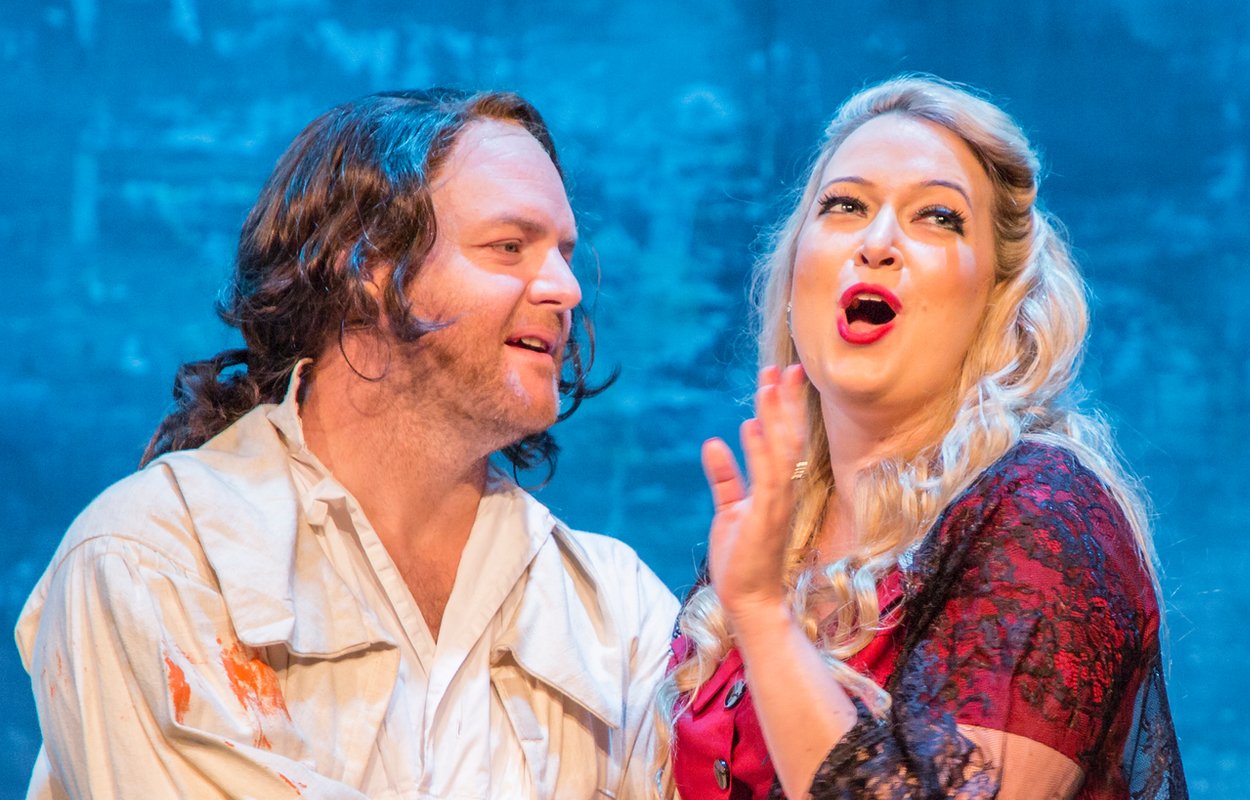
Puccini's Tosca
Opera Brava's production of
Puccini's Tosca
act i
ROME, 1941, MORNING:
Sant’Andrea della Valle to hide in one of the chapels. Once he has disappeared, a sacristan enters and then the painter Mario Cavaradossi, who continues work on his portrait of The Madonna. The painting has been inspired by the Marchesa Attavanti, whom Cavaradossi has seen in the church but does not know. While he works, he compares the blond beauty of his lover, the singer Floria Tosca, to that of the blonde Marchesa Attavanti. Angelotti, a member of the former government, ventures out and is recognized by Cavaradossi. The painter gives him food and hurries him back into the chapel as Tosca is heard calling from outside. Suspicious, she jealously questions Cavaradossi, then reminds him of their rendezvous that evening at his villa. Suddenly recognizing the Marchesa Attavanti in the painting, she accuses him of being unfaithful, but he assures her of his love. Once Tosca has left, Angelotti emerges from the chapel. A cannon shot signals that the police have discovered the escape, and he and Cavaradossi flee to the painter’s villa. The sacristan enters with the news that Italian forces have won a significant victory over their enemies and that there will be a Te Deum sung in the church in celebration. The excitement is silenced by the arrival of Scarpia, chief of the secret police, who is searching for Angelotti. When Tosca comes back looking for Cavaradossi, Scarpia shows her a fan with the Attavanti crest that he has just found. Seemingly finding her suspicions confirmed, Tosca bursts into tears. She vows vengeance and leaves for Cavaradossi’s Villa. Scarpia sends his men to follow her in the belief that he will thereby discover Angelotti. While the congregation sing the Te Deum in the Church above the crypt, Scarpia declares that he will bend Tosca to his will.
act ii
EVENING:
In his quarters at the Farnese Palace, Scarpia sadistically anticipates the pleasure of having Tosca in his power. The spy Spoletta arrives, explaining that he was unable to find Angelotti. Instead he brings in Cavaradossi. While Scarpia interrogates the painter, Tosca is heard singing at a royal gala in the same building. Scarpia sends for her and she enters just as Cavaradossi is being taken away to be tortured. Frightened by Scarpia’s questions and Cavaradossi’s screams, Tosca reveals Angelotti’s hiding place. Cavaradossi is carried in, hurt and dazed. Realizing what has happened, he angrily confronts Tosca, when the officer Sciarrone rushes in to announce that, in a surprise attack the Fascist forces have suffered a heavy defeat. Cavaradossi shouts out his defiance of tyranny and is dragged away to be executed. Scarpia, calmly resumes his work and suggests to Tosca that he would let Cavaradossi go free if she’d give herself to him. Fighting off his advances, she calls on God, declaring that she has dedicated her life to art and love. Scarpia insists, when Spoletta interrupts: faced with capture, Angelotti has killed himself. Tosca, now forced to give in or lose her lover, agrees to Scarpia’s proposition. He seemingly orders a mock execution for Cavaradossi, after which he is to be freed. Spoletta leaves. As soon as Scarpia has written a safe-conduct for the lovers, Tosca kills him with a paper knife she had seen earlier on his desk. Wrenching the document from his hand, she quietly leaves the room.
act iii
DAWN:
Cavaradossi awaits execution in his Prison cell. He bribes a jailer to deliver a farewell letter to Tosca. Overcome with memories of love, he gives in to his despair. Tosca enters. She explains to him what has happened and the two imagine their future in freedom. As the execution squad appears, Tosca instructs Cavaradossi how to fake his death convincingly. The soldiers fire and depart. Tosca urges Cavaradossi to hurry, but when he doesn’t move, she realizes that Scarpia has betrayed her and that the bullets were real. Spoletta and Sciarrone rush in to confront Tosca but she cries out to Scarpia and commits suicide.

